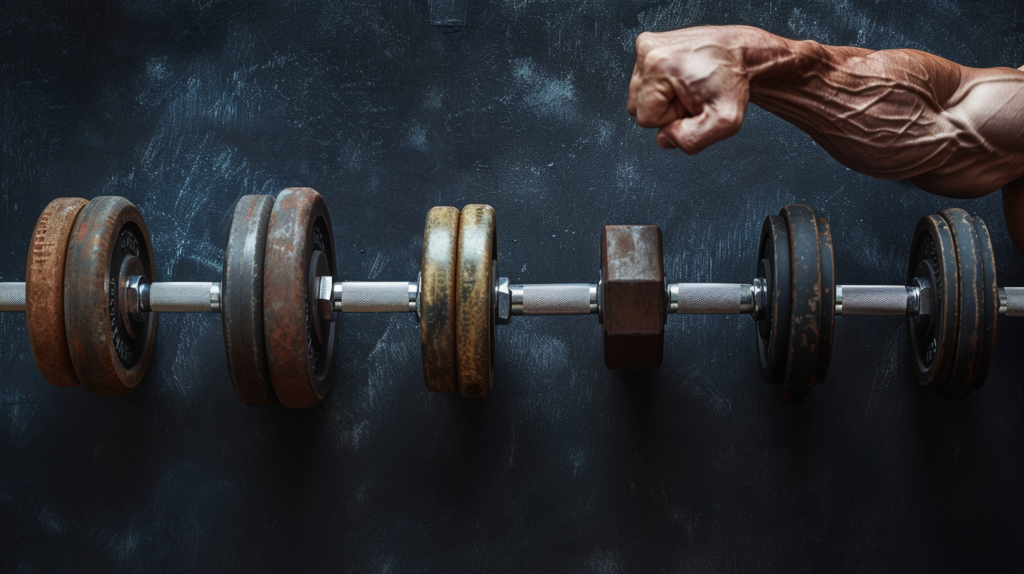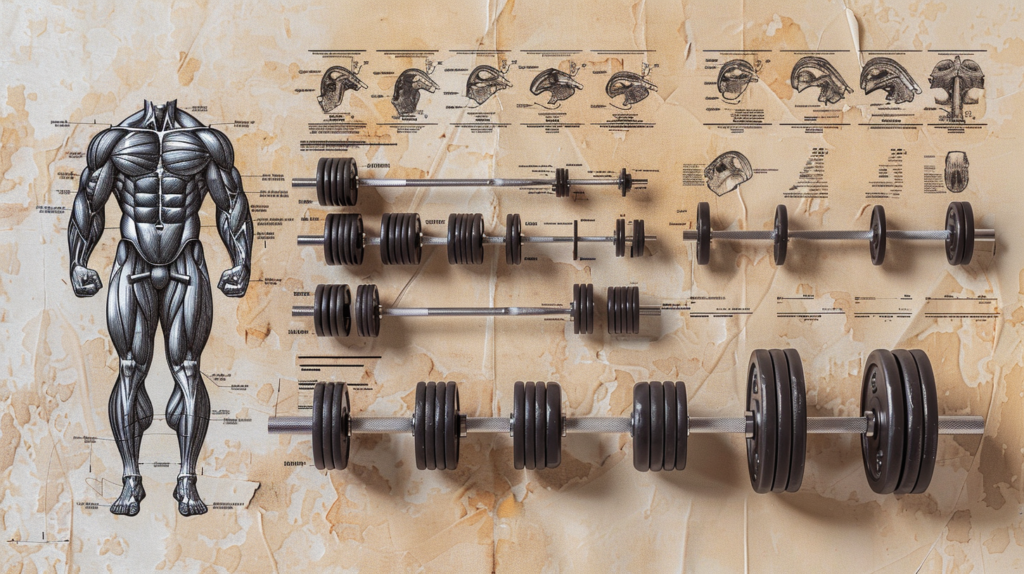Tremendous muscle gains await those who understand the importance of progressive overload in musclebuilding.
Progressive overload is essential for musclebuilding as it prompts muscle adaptation to resistance training. By gradually increasing intensity, we stimulate muscle growth through microscopic tears and repair. This incremental challenge leads to enhanced strength and long-term gains. Ensuring proper form, avoiding sudden jumps in intensity, and listening to body cues are important. By monitoring progress and adjusting overload levels, we prevent plateaus and optimize muscle development. Understanding the benefits and science behind progressive overload is key to achieving desired muscle growth outcomes. Continuously adjusting workout intensity based on progress is necessary for sustained musclebuilding success.
Key Takeaways
- Stimulates muscle adaptation and growth through incremental intensity increases.
- Prevents plateauing by continuously challenging muscles.
- Enhances strength gains and prevents injuries.
- Facilitates long term muscle growth and development.
- Optimizes muscle hypertrophy by progressively overloading muscles.
The Concept of Progressive Overload

Progressive overload is a pivotal principle in musclebuilding that involves gradually increasing the intensity of your workouts to stimulate muscle growth. This concept is grounded in the physiological phenomenon known as muscle adaptation, where muscles respond to the stress of resistance training by growing stronger and larger over time. Resistance training, which includes activities like weightlifting, bodyweight exercises, and resistance band workouts, places stress on the muscles, triggering microscopic damage at the cellular level.
When we engage in resistance training, our muscles experience microscopic tears that stimulate the body to repair and rebuild them stronger than before. This process of muscle adaptation is essential for muscle growth and is the foundation of progressive overload. By progressively increasing the resistance or load during workouts, we continually challenge our muscles, forcing them to adapt and grow in response to the increased demands placed upon them.
Scientific research supports the effectiveness of progressive overload in promoting muscle hypertrophy. Studies have shown that systematically overloading the muscles through incremental increases in intensity leads to greater muscle growth compared to maintaining the same level of resistance. By understanding and implementing the concept of progressive overload in our training regimen, we empower ourselves to achieve greater gains in muscle strength and size, ultimately advancing towards our fitness goals.
Benefits of Progressive Overload

Moving forward from our exploration of the physiological basis of muscle adaptation, it is imperative to examine the tangible benefits that embracing progressive overload can offer in the domain of musclebuilding. Progressive overload, characterized by gradually increasing the demands placed on the body during exercise, plays a pivotal role in achieving long term gains and strength gains. This gradual increase in intensity challenges the muscles, prompting them to adapt and grow stronger over time.
How Progressive Overload Stimulates Muscle Growth

Studying the impact of gradual increases in exercise intensity on muscle growth provides valuable insights into the mechanisms driving physiological adaptation. Muscle adaptation and growth are intricately linked to the concept of progressive overload. When we subject our muscles to increasingly challenging demands through progressive overload, we stimulate a cascade of physiological responses that ultimately lead to muscle growth.
Progressive overload induces a series of events within the muscle fibers. Initially, the stress placed on the muscles during resistance training causes microtears in the muscle fibers. In response to these microtears, the body activates satellite cells to facilitate repair and growth. This process, known as muscle hypertrophy, involves an increase in the size of individual muscle fibers, resulting in overall muscle growth.
Moreover, progressive overload not only promotes muscle growth but also enhances strength and endurance gains. By gradually increasing the intensity, volume, or frequency of our workouts, we continually challenge our muscles, forcing them to adapt and become stronger over time. This adaptation is essential for achieving significant improvements in muscle strength and endurance.
In essence, progressive overload serves as the catalyst for muscle growth by stimulating the physiological processes that lead to muscle adaptation. Through a strategic approach to progressively challenging our muscles, we can maximize their full potential for growth, strength, and endurance gains.
Implementing Progressive Overload in Workouts

To effectively implement progressive overload in workouts, it’s essential to carefully plan and monitor the gradual increase in exercise intensity. Progressive overload variations involve systematically challenging the muscles to adapt to increased stress over time. This can be achieved by manipulating various training variables such as weight, repetitions, sets, rest periods, and exercise selection.
One way to implement progressive overload is by increasing the weight lifted during resistance training gradually. By adding small increments of weight to the barbell or dumbbells, you can continually push your muscles to handle heavier loads, promoting strength and muscle gains. Another approach is to enhance workout intensity by performing more repetitions with the same weight or by reducing rest periods between sets.
Monitoring workout intensity is vital when applying progressive overload. Keeping a workout log or using a fitness tracking app can help you track your progress and make sure that you’re consistently challenging yourself. It’s important to listen to your body and make adjustments as needed to prevent plateaus and minimize the risk of overtraining.
Incorporating progressive overload variations into your workout routine can lead to continuous improvements in strength, muscle size, and overall fitness levels. By strategically increasing the demands placed on your muscles, you can optimize your training outcomes and achieve your muscle-building goals effectively.
Common Mistakes to Avoid With Progressive Overload

When aiming for progressive overload in workouts, it’s important to be mindful of common mistakes that can hinder the effectiveness of the training regimen. One of the most prevalent errors is sacrificing proper form in pursuit of heavier weights or more repetitions. Maintaining correct form is essential not only for preventing injuries but also for targeting the intended muscle groups effectively. Without proper form, the risk of strain on joints and connective tissues increases, leading to setbacks rather than progress.
Another mistake to avoid is making sudden or excessive increases in weight or volume. Progressive overload should be a gradual process to allow the body to adapt and grow stronger over time. Abrupt jumps in intensity can lead to overtraining, plateaus, or even injuries. It’s important to listen to your body’s signals and progress at a sustainable pace that aligns with your individual fitness level.
Furthermore, neglecting adequate rest and recovery can impede the benefits of progressive overload. Muscles need time to repair and grow stronger after being subjected to increased demands. Failing to prioritize recovery can hinder progress and increase the risk of burnout or overuse injuries. Balancing challenging workouts with sufficient rest is essential for maximizing the benefits of progressive overload and promoting muscle growth effectively.
Tracking Progress and Adjusting Overload Levels

Effective musclebuilding progress hinges on meticulously monitoring advancements in performance and fine-tuning overload levels accordingly. Progress tracking is vital to guarantee that gains are being made consistently over time. Measuring gains can be done through various methods such as tracking strength increases, muscle endurance, or changes in muscle mass. By keeping detailed records of these metrics, individuals can pinpoint areas of improvement and identify patterns in their progress.
Adjusting intensity is an important aspect of progressive overload. As individuals become stronger and more adapted to their current workout routines, it’s important to periodically increase the overload to continue stimulating muscle growth. This adjustment can be achieved by manipulating variables like weight, reps, sets, or rest periods. By gradually increasing the intensity of workouts, individuals can ensure that their muscles are continually challenged and forced to adapt, leading to ongoing progress.
Monitoring progress and adjusting overload levels go hand in hand. Without tracking advancements and making necessary adjustments, individuals may hit plateaus where muscle growth stagnates. By staying vigilant and proactive in measuring gains and adjusting intensity, individuals can optimize their musclebuilding journey and achieve their desired results. Remember, progress isn’t linear, and adapting overload levels to match your evolving strength levels is key to consistent growth and development.
Frequently Asked Questions
How Often Should I Change My Progressive Overload Strategy?
We adjust our progressive overload strategy based on training frequency, adaptation, and recovery needs. Incorporating deload weeks strategically can prevent plateaus and aid in overall performance. It’s important to listen to your body’s signals for best results.
Can Progressive Overload Help Prevent Muscle Plateaus?
Progressive overload can combat muscle plateaus by challenging muscles to grow stronger. It aids in strength gains, manages fatigue, and promotes long-term progress while preventing injuries. Consistent progression is key for continual improvement.
Is Progressive Overload Suitable for All Fitness Levels?
Can progressive overload cater to all fitness levels? Yes, with beginner modifications and advanced techniques. Individual progress trumps group comparisons. Embrace the challenge, adapt, and grow. Fitness is a journey, not a destination.
How Do I Know if I Am Overloading Too Much?
We monitor overloading by noticing warning signs like persistent soreness, fatigue, or decreased performance. To prevent injuries, we incorporate deload periods for recovery. Balancing intensity and rest is essential for sustainable progress and muscle development.
Should I Adjust Overload Levels for Different Muscle Groups?
We tailor overload levels for different muscle groups to guarantee muscle symmetry and individual muscle overload progression. This approach optimizes muscle development and minimizes imbalances. Consistent monitoring and adjustments enhance overall strength gains and physique progress.
Conclusion
To sum up, ideal progressive overload is crucial for maximizing muscle growth. By gradually increasing the stress placed on muscles, individuals can continuously challenge and stimulate muscle fibers to adapt and grow.
Consistent application of progressive overload, coupled with proper tracking and adjustment, is key to achieving maximum gains in strength and muscle mass. Remember, persistence and precision in implementing progressive overload principles will pave the path to powerful muscle progress.













